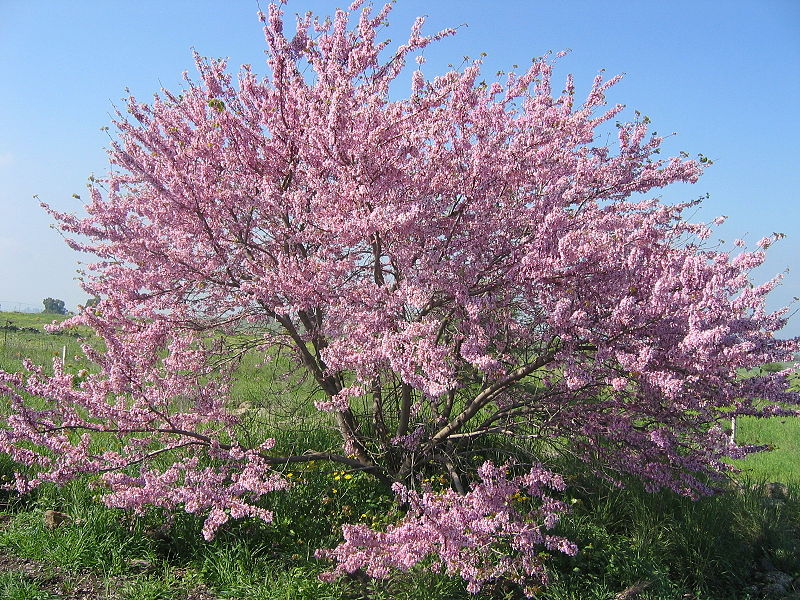 This deciduous small understory tree also is native to the the woodlands of southern Europe and western Asia and is believed to be native to Palestine. It is also called Mediterranean redbud and is a member of the pea family, Fabaceae, that also includes beans, lupines, and mimosa. The trees grow up to 36′ feet tall and have usually have multiple stems and a rounded crown. The heart-shaped leaves are bronze when they first appear in spring but change to blue-green by summer, and to yellow in the fall. Cluster of 3-6 deep pink flowers appear on old wood including the trunk before and while the leaves are coming out on the tree and are followed by pendulous flat woody pods that resemble weaver’s shuttles. At 3/4″ long the flowers of this species are larger than the flowers of other members of the genus. The trees add a beautiful presence in shrub borders, on the edges of woodland, and other natural settings. They are easily damaged by winds or early frosts, and resent being transplanted. Although myth claims that the name refers to the use of this tree by Judas Iscariot to hang himself, that is not the case. In France the tree is called ‘l’arbre de Judee’ which is translated as ‘the tree from Judeae’ and the common name derives from the French. The genus name, Cerci, comes from the Greek word kerkis meaning weaver’s shuttle and refers to the shape of the seed pods. The specific epithet, siliquastrum comes from the Latin word siliqua meaning pod and the suffix –astrum meaning partial resemblance. Cultivars are available with light pink, purple,magenta, and white flowers.
This deciduous small understory tree also is native to the the woodlands of southern Europe and western Asia and is believed to be native to Palestine. It is also called Mediterranean redbud and is a member of the pea family, Fabaceae, that also includes beans, lupines, and mimosa. The trees grow up to 36′ feet tall and have usually have multiple stems and a rounded crown. The heart-shaped leaves are bronze when they first appear in spring but change to blue-green by summer, and to yellow in the fall. Cluster of 3-6 deep pink flowers appear on old wood including the trunk before and while the leaves are coming out on the tree and are followed by pendulous flat woody pods that resemble weaver’s shuttles. At 3/4″ long the flowers of this species are larger than the flowers of other members of the genus. The trees add a beautiful presence in shrub borders, on the edges of woodland, and other natural settings. They are easily damaged by winds or early frosts, and resent being transplanted. Although myth claims that the name refers to the use of this tree by Judas Iscariot to hang himself, that is not the case. In France the tree is called ‘l’arbre de Judee’ which is translated as ‘the tree from Judeae’ and the common name derives from the French. The genus name, Cerci, comes from the Greek word kerkis meaning weaver’s shuttle and refers to the shape of the seed pods. The specific epithet, siliquastrum comes from the Latin word siliqua meaning pod and the suffix –astrum meaning partial resemblance. Cultivars are available with light pink, purple,magenta, and white flowers.
Type: Deciduous flowering tree
Outstanding Feature: Flowers
Form: Loosely rounded
Growth Rate: Slow
Bloom: Clusters of small deep pink flowers in spring on old wood
Size: 36’ H x 30’ W
Light: Full sun to light shade
Soil: Fertile, moist, well-drained, alkaline
Hardiness: Zones 6-9
Care: Low maintenance
Pests and Diseases: Susceptible to scale, leafhoppers, psyllids, canker, coral spot and verticillium wilt
Propagation:Fresh seed sown in autumn and over wintered in cold frame; semi-ripe cuttings, budding
Photo Credit:Wikipedia-מאוסף-התמונות-של-אורנה-לוטן
